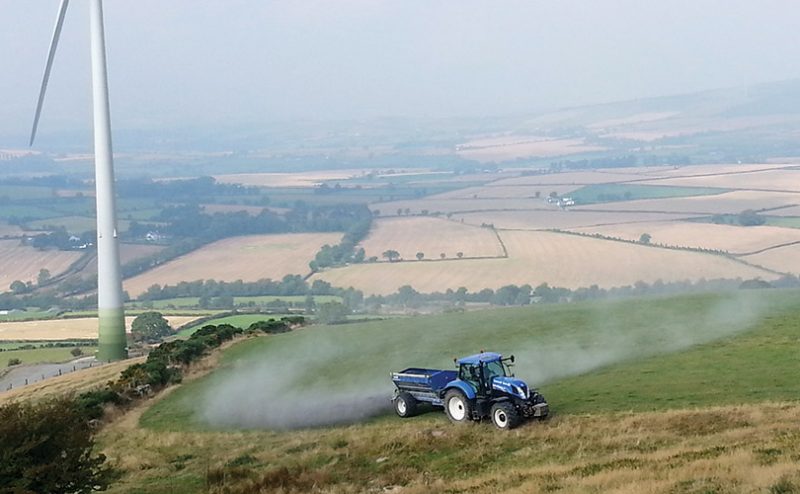
Average national land prices fell by 6% year on year in 2019 driven in the main by a decrease in the prices for dairy, beef and cereals.
The Society of Chartered Surveyors Ireland / Teagasc Agricultural Land Market Review and Outlook Report 2020 found the average price of an acre nationally without a residence was €8,823 in 2019. This compares to a national average of €9,346 in 2018.
Munster recorded the biggest yearly fall in selling price at 9%, while selling prices fell 6% in Leinster and just 1% in Connacht/Ulster last year.
The average price per acre without a residence in 2019 in Leinster was €10,224 per acre, with Munster on €9,719 and Connacht/Ulster on €6,527.
The survey of 163 chartered surveyors from all over the country was conducted in December and early January 2020, pre-Covid-19.
While selling prices fell overall in 2019, there was considerable variation in land price movements depending on the size of the land area transacted, whether it had a residence or not and its location. In some instances, price increases were recorded, bucking the overall downward trend in selling prices.
Although Munster recorded the biggest fall in land prices, the province recorded the biggest increases in rental prices last year.
Whether for grazing/silage or tillage, land rental prices increased in both Munster and Connacht/Ulster in 2019. However, the extent of the increase varied considerably, with increases for potato land going as high as 14% in Munster and increases for cereal land of 12% in Connacht/Ulster.
The picture was more mixed in Leinster with a fall in rental prices for grazing/silage and cereal land in 2019 and higher rental prices for potato and other crop land.
Miah McGrath, Chair of the SCSI’s Rural Agency Group, said the report’s findings – the fall in land prices and the rise in rental values – reflected the fall in farm output prices and increased demand from farmers to lease land. But he said Covid-19 remained the great unknown in terms of developments this year.
“The sudden emergence of the Covid-19 crisis and the speed at which it has moved has created a negative demand shock for farming. While consumption of food within the home has increased, this has been more than offset by reduced consumption outside the home. As a result, meat and dairy commodity prices have fallen. The short-term economic impact is likely to be quite negative, but the effect on land prices will probably depend on the duration of the crisis and this makes it very difficult to predict future price moves.”
“Up to this Brexit had been a major concern and our findings indicate that 74% of SCSI members believe fears over Brexit deterred buyers, while 63% believed it deterred sellers. Given the negative economic effect Covid-19 will have, the importance of the EU and the UK agreeing a trade deal this year, is now more important than ever. Purchaser confidence is likely to remain weak until more clarity on both issues emerges.”
“While the volume of sales in 2019 was broadly similar to 2018, one trend we are seeing is an increased demand for long term leases. Fifty-six-per-cent of respondents nationally reported increased demand for longer leases – leases exceeding five years – while 40% said the average duration of lease agreements increased. As one agent commented, leases may be lengthening because it’s a safer option than buying land, especially if its difficult to raise capital,” McGrath said.
Jason Loughrey, of the Teagasc Agricultural Economics and Farm Surveys Department said that while all sectors benefitted from more normal weather conditions following the snow and drought of 2018, last year also saw across the board decreases in output prices for dairy, drystock and particularly for cereals.
Trevor Donnellan, Head of the Teagasc Agricultural Economics and Farm Surveys Department said; “Milk prices were down 5.6%, beef was down 6%, lamb was down 5.8% and cereals dropped between 25 to 30%. Although some of the decreases were offset by increased yields and lower input costs, 2019 proved a particularly challenging year for beef farmers, with additional supports required to maintain beef farm incomes.”
“How will the agriculture sector cope with the disruption caused by Covid-19? It will depend on the economic health of the various parts of the agricultural sector in advance of the crisis, the actions taken by the agri-food sector itself during the crisis and the supports available to the sector to manage its way through it. A build up and overhang of stocks in some sectors could be one of the challenges that has to be dealt with as part of the recovery process.”
“While it is very difficult to forecast how 2020 will play out for Irish agriculture, it will undoubtedly test the resilience of the sector. However taking a slightly longer view, the agri-food sector should be one of the first to see the benefits of a return to normal activity,” Donnellan concluded.
Long term prices
This year’s report includes a long-term price series for land sales and land rental prices which has never previously been publicly available. The data, from Smith Harrington, a firm of Chartered Surveyors and Estate Agents founded in Meath in 1870, shows that over the last 50 years the price of an acre varied from a low of €290 in 1970 to a high of over €20,000 in 2007 at the height of the Celtic Tiger, before falling to between €9,000 to €10,000 in recent years.